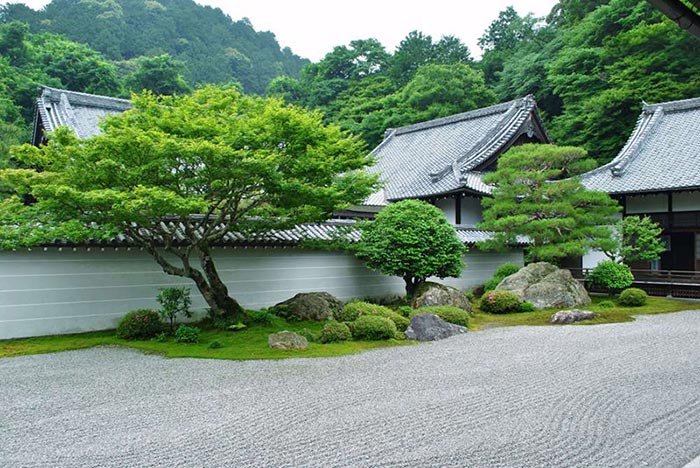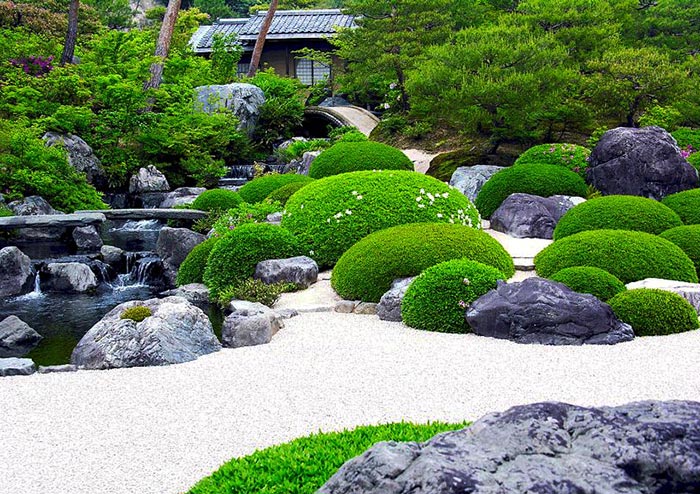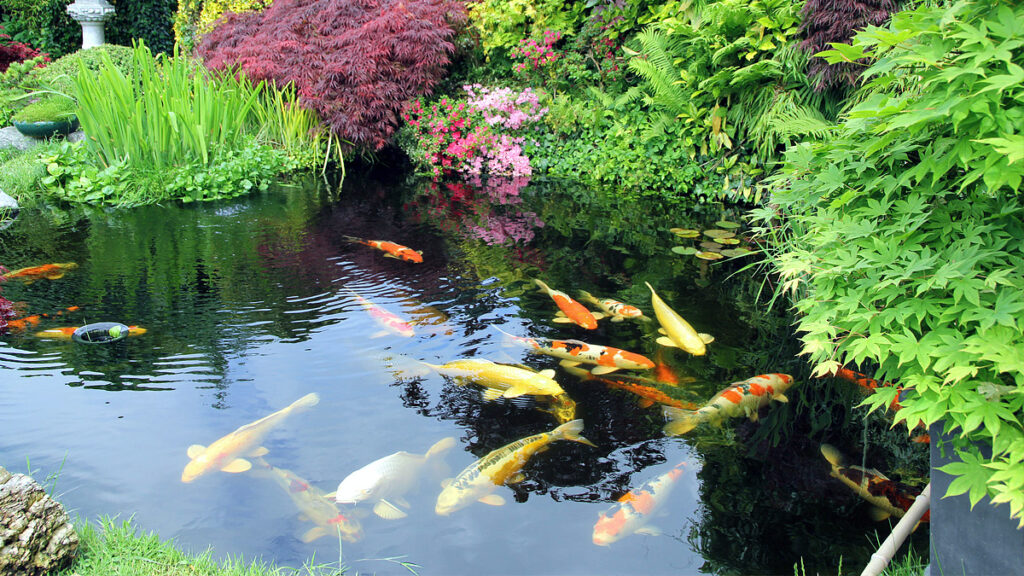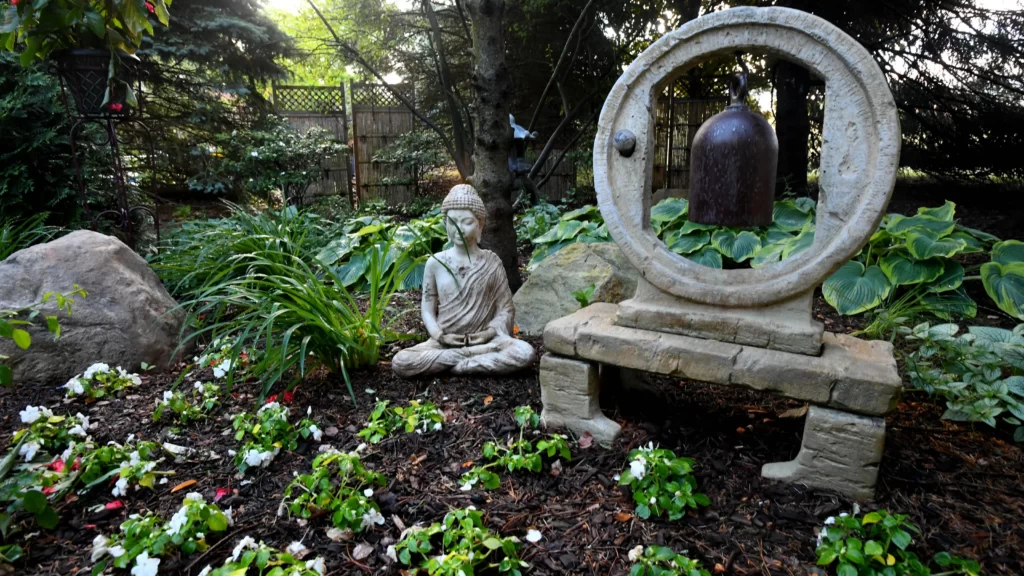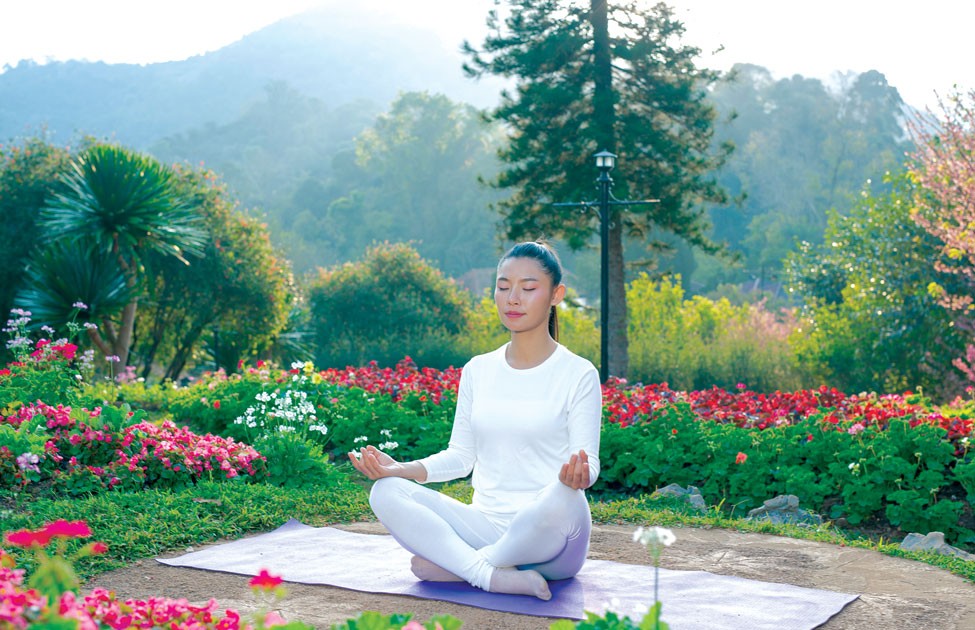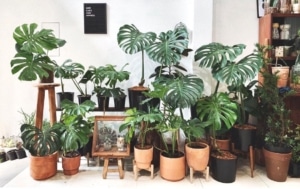Designing a meditation garden is a confluence of art, science, philosophy, and personal introspection. It requires a thoughtful, as it aims to create a tranquil space that not only approach the aesthetic appeal of a location but also serves as a sanctuary for contemplation and mindfulness.
A well-designed garden reflects the natural world, encourages self-reflection, and fosters a sense of peace and serenity. In this detailed guide, LotusBuddhas will list the key factors involved in designing a meditation garden, such as size determination, location selection, layout planning, plant selection… to help you visualize what your meditation garden will look like, then start implementing it.
1. Size determination
Designing a meditation garden involves various elements, one of the most critical being the determination of the garden’s size. Understanding the space allocation for your meditation garden is paramount as it sets the foundation for the planning and execution of the entire project.
Before embarking on any design ideas, conduct a thorough assessment of your available outdoor space. Remember that meditation gardens, unlike traditional gardens, do not necessarily require large expanses of land. Even a small, secluded corner can serve as an intimate meditative haven. The crucial factor is that it should be a space where you feel comfortable and can cultivate a sense of tranquility and peace.
You might want to consider both the functional and aesthetic elements when determining the garden size. Functionally, the space must be sufficient to accommodate the primary activities you envision for your meditation garden, such as yoga, seated meditation or walking meditation. Aesthetically, the garden should harmoniously blend with the existing architectural and natural elements of your home environment, not appearing too cramped or too sparse.
When you’ve identified the appropriate size for your meditation garden, sketch or map out the space to start the design process. This step will give you a visual perspective of your garden’s layout, enabling you to plan other elements such as paths, plants, seating areas and water features more effectively.
2. Location
The selection of an appropriate location forms the bedrock of the design process for a meditation garden. This strategic decision influences the overall atmosphere and efficacy of the garden as a place for calm and contemplation.
An ideal location for a meditation garden is one that ensures privacy and seclusion, as the purpose of such a space is to provide a refuge from the hustle and bustle of daily life. The garden should be positioned in a part of your outdoor space that is relatively shielded from the street or neighboring properties, fostering a sense of personal sanctuary.
The ambient noise level is another critical factor to consider when determining the location. A serene environment, free from intrusive noises such as traffic, loud neighbors, or mechanical equipment, is crucial for fostering a peaceful meditative atmosphere. If absolute quiet is not feasible, consider how the addition of natural sound barriers or soothing sound elements, such as water features or wind chimes, can help mask undesirable noise.
The availability of natural light is another vital aspect. A location that receives ample morning sunlight might be preferred for its gentle, serene quality, while an area that enjoys the cooler, softer light of the evening may be suitable for winding down at the end of the day.
Lastly, consider the natural elements of the chosen location. Existing trees could provide beneficial shade or a visually pleasing backdrop. If your property overlooks a beautiful view or natural landscape, positioning your meditation garden to take advantage of this can enhance the sense of connection with nature, a key element in meditation and mindfulness practices.
3. Layout
The layout forms the architectural skeleton of your meditation garden, serving as a blueprint for organizing the various elements of your tranquil sanctuary. A carefully thought-out layout encourages fluidity of movement, cohesiveness in design, and enhances the overall meditative experience.
A primary consideration for your garden layout should be simplicity and uncluttered space. This minimalist approach is not only in keeping with the traditional Zen-inspired aesthetic but also encourages a clearer mindset for meditation. Ensure your paths and areas for sitting, practicing yoga, or other meditation activities are defined and clear of obstructions.
Start by designating a focal point for your garden, which could be a significant tree, an art piece, a water feature, or a specific area for seated meditation. This focal point provides a visual anchor and draws the visitor into the garden, fostering a sense of direction and purpose.
Next, consider the path leading through the garden. A well-designed pathway not only provides physical direction but can also symbolize the personal journey one undertakes in meditation. Paths can be straight or meandering, depending on your preference, but should allow for easy, unhindered movement through the space.
Designate areas for meditation or relaxation. Depending on your practices, you might require a flat area for yoga or a comfortable seat for mindful sitting. These areas should be away from distractions, ensuring a sense of peace and tranquility.
The layout should also account for the placement of vegetation and other elements. Consider the size, color, texture, and year-round appearance of plants when deciding where they best fit in the garden. Rocks, water features, and other structural elements should be integrated seamlessly, contributing to the overall harmony of the garden. Lastly, keep in mind that the layout should facilitate easy maintenance. Creating a design that allows for easy access to plants for pruning and other care can help reduce potential stress associated with garden upkeep.
4. Plant selection
Plant selection plays a significant role in shaping the aesthetic and mood of a meditation garden. The right mix of plant species can serve to enhance the sense of tranquility and peace inherent to such spaces, as well as contribute to the overall visual harmony.
When selecting plants for your meditation garden, prioritize species that invoke a sense of calm and serenity. Consider plants with soft textures and soothing colors such as shades of green, blue and white. Bright, vibrant colors might be visually stimulating but could potentially detract from the serene atmosphere desired in a meditation garden.
Varieties with aromatic properties like lavender, jasmine, or rosemary can be an excellent addition, as their scents can aid in relaxation and stress relief. However, be mindful not to create an overpowering mix of different fragrances, which could be more distracting than calming.
From a structural perspective, consider a balance between evergreen plants and those that change with the seasons. Evergreens provide a constant, reliable presence, offering visual structure throughout the year. On the other hand, deciduous plants and flowers can add a dynamic element to your garden, changing their appearance with the seasons and reminding us of the cycles of life and impermanence.
It’s also important to consider the maintenance needs of your chosen plants. A meditation garden should induce relaxation, not additional work. Opt for plants that are suitable for your climate and soil conditions and are known to be disease-resistant and relatively easy to care for.
Consideration of height and scale is another crucial aspect. Select a mix of trees, shrubs, and ground cover plants to create layers, adding depth and interest to the garden. Taller plants can be used to create a sense of enclosure or privacy, while lower plants can guide the eye and contribute to the overall flow of the garden. If you’re creating a traditional Zen meditation garden, you might want to include moss, which is a common plant in such gardens due to its soft texture and the sense of age and tranquility it imparts.
5. Rock and sand elements
Incorporating rock and sand elements into the design of a meditation garden draws inspiration from the Zen gardens of Japan and offers both aesthetic and symbolic richness to the space.
Rocks, the more permanent and visually impactful of the two, serve multiple purposes in a meditation garden. They can act as central features, providing visual interest and focus, or as structural elements defining the layout of the garden and its paths. When selecting rocks, consider their size, shape, and color, and how these attributes align with the overall design of your garden.
The arrangement of rocks is also significant. In Zen tradition, rocks are often grouped in odd numbers and arranged in a way that appears natural and unforced. Each rock should be placed with its best face exposed, and the grouping should be balanced yet asymmetrical, adding to the sense of naturalness. Some designs may incorporate larger rocks to symbolize mountains or islands, adding a symbolic layer to the garden’s layout.
Sand, or fine gravel, offers a contrasting but complementary element to the rocks. In a Zen garden, sand often symbolizes water, and it can be raked into patterns that mimic the ripple of water waves, creating a sense of motion and dynamism in an otherwise static garden. The act of raking the sand itself can be a form of mindful meditation, fostering focus and tranquility.
However, the use of sand isn’t just limited to mimicking water. It can also serve as a neutral ground cover that highlights the other elements of the garden, or be used in areas intended for walking or sitting, adding a tactile element to the garden experience.
Keep in mind that the color of the sand should harmonize with the color of the rocks and other garden elements. Furthermore, maintenance is a consideration, as the raked patterns in the sand may need regular upkeep, especially in windy weather or regions with abundant wildlife.
6. Water features
The incorporation of water features in a meditation garden design can significantly enhance the atmosphere of serenity and tranquility. Water features, such as ponds, waterfalls, or fountains, can serve both aesthetic and functional purposes in a meditation garden.
From a visual standpoint, water features add an element of dynamism and depth to a garden’s design. Depending on the style, a water feature can be a dramatic focal point or a subtle enhancement to the overall aesthetic. For instance, a pond with Koi fish can be a striking, lively addition, while a simple stone basin with a bamboo water spout can provide a quieter, more subdued presence.
Functionally, the sound of gently flowing or trickling water can provide soothing background noise that aids relaxation and focus during meditation. This ambient sound can also help to mask more intrusive background noises, such as traffic or nearby conversation, thus fostering a more peaceful environment.
When designing a water feature, several factors should be considered. The scale of the feature should be in proportion with the rest of the garden to maintain balance in the overall design. The water feature’s style should also harmonize with the overall aesthetic of the garden – for instance, a sleek, modern fountain may be out of place in a garden designed to evoke a traditional Zen aesthetic.
Maintenance considerations are also crucial. Water features require regular cleaning and potential winterizing in colder climates to keep them functioning properly and looking their best. If a lower maintenance option is preferred, a small, self-contained fountain or a birdbath could be a good alternative to a large pond or waterfall.
The placement of the water feature is another important aspect. It could be situated to draw visitors deeper into the garden, provide a pleasant surprise along a garden path, or serve as the focal point of the garden, visible from a meditation seating area.
7. Seating areas
The design of seating areas in a meditation garden is a vital aspect that requires thoughtful consideration, as it is these spaces that will be directly interacted with during periods of contemplation, meditation, or relaxation.
The primary consideration when designing seating areas should be comfort and tranquility. The seats should be comfortable enough to sit on for extended periods, and the area should provide a sense of peace and calm. This can be achieved by selecting a location that is shielded from noise and distractions, perhaps under the dappled shade of a tree, or adjacent to a soothing water feature.
Next, consider the views from the seating area. Ideally, the seat should be positioned to provide pleasing views of the most attractive parts of the garden, or the focal point such as a unique plant, statue, or water feature. In a Zen-style meditation garden, the seating area could face a carefully raked sand area, providing an ever-changing art piece to focus on.
The material of the seating is another crucial factor. It should be durable and weather-resistant, yet blend seamlessly with the garden’s aesthetic. Natural materials like stone or wood are often preferred for their organic look and feel, but they should be properly treated or maintained to endure the elements.
Seating areas can be as simple as a single bench for solitary meditation or more elaborate setups for group meditation sessions. In some cases, a flat stone or wooden platform might be preferable, particularly if the garden is also used for yoga or similar practices.
It is also worth considering the inclusion of small side tables or flat surfaces in the seating area design. These can provide a place for meditation accessories like incense, bells, or a cup of tea.
LotusBuddhas would like to remind you that the goal of a meditation garden is to provide a peaceful, calming environment. Seating areas should therefore not be overly complicated or crowded, but simple and tranquil, facilitating the process of mindfulness and relaxation.
8. Lighting
The addition of lighting to a meditation garden is an important aspect of design that can greatly enhance its atmosphere, aesthetic appeal, and usability, especially during dawn, dusk or night.
When considering lighting for a meditation garden, the primary goal should be to create a calm, serene environment that facilitates relaxation and mindfulness. Therefore, lighting should be soft, subtle, and designed to highlight the garden’s key features without being overly bright or distracting.
One effective strategy is to use low-voltage, LED, or solar-powered lights that emit a warm, soft glow. These can be installed along paths to guide visitors, placed near water features to create reflective effects, or positioned to illuminate specific plants or architectural features. Avoid harsh, direct lighting that can create stark shadows and interfere with the peaceful ambiance.
Another consideration is the color of the light. Warm colors, such as amber or soft white, can create a tranquil and inviting atmosphere, while cooler colors might disrupt the sense of tranquility. Colored lighting can also be used sparingly for specific effects, but it should be used judiciously to avoid creating a visually busy or overly colorful environment.
Uplighting, where lights are placed on the ground and aimed upwards, can be used to highlight trees, statues, or structures, creating dramatic shadows and enhancing the sense of depth in the garden. Similarly, downlighting can create a calm, moonlight effect, but it requires careful positioning to prevent the light from shining directly into the eyes.
In a Zen or Japanese-style meditation garden, traditional lanterns can be an aesthetically pleasing and culturally appropriate lighting option. They can provide soft illumination and add to the garden’s overall aesthetic. For a modern, minimalist garden, sleek, contemporary light fixtures may be more appropriate.
If your meditation garden is used predominantly during the day, lighting may not be a significant factor. However, having some form of lighting can extend the usability of the garden into the early morning or evening hours and add a different dimension to its beauty.
9. Art & Symbolism
The integration of art and symbolism in a meditation garden can deepen its spiritual significance, enhance its aesthetic appeal, and create a space that is imbued with personal or cultural meaning.
Artistic elements can take many forms in a meditation garden, including statues, carvings, ornamental stones, mosaics, or other decorative pieces. These can serve as focal points within the garden, drawing the eye and providing a visual anchor for meditation. The specific selection of art pieces should harmonize with the overall aesthetic of the garden and reflect the cultural or spiritual tradition that the garden is intended to evoke.
Symbolism can be an intricate part of a meditation garden’s design. Many traditional meditation gardens, such as Japanese Zen gardens, are rich with symbolic elements. Rocks may represent islands or mountains, raked sand or gravel can symbolize water or waves, and paths can stand for life’s journey. Symbolic elements offer layers of meaning to contemplate during meditation and can create a deeper connection to the space.
Personal symbolism can also be integrated into a meditation garden’s design. This might include favorite plants, objects that hold personal significance, or elements that represent cherished ideas or memories. Such elements can help to create a stronger emotional connection to the space and foster a deeper sense of peace and mindfulness.
However, you must to exercise restraint and careful consideration when integrating art and symbolism into a meditation garden. Overcrowding the space with too many objects or overly intricate designs can detract from the garden’s tranquility and simplicity, key characteristics of a meditation space. Each piece should be thoughtfully placed to contribute to the overall harmony and balance of the garden.
Moreover, remember that the meaning behind any symbolic elements should resonate with the individual using the space. If a garden is designed for public use or for people from various cultural backgrounds, it’s crucial to ensure that the symbols used are universally recognized as peaceful and positive, or at least are not offensive to any cultural group.
10. Maintenance
The aspect of maintenance is a critical consideration when designing a meditation garden. Ensuring that the garden remains a serene and aesthetically pleasing space over time requires thoughtful planning and regular upkeep.
Firstly, select plants that are appropriate for the local climate and soil conditions. This will not only improve the health and appearance of the plants but also reduce the amount of watering, fertilizing, and pest control required. Native plants can often be a good choice, as they typically require less maintenance than exotic species.
Similarly, consider the growth habits and maintenance needs of the plants you choose. Some plants may require regular pruning to maintain their shape, while others may drop leaves or seeds that need to be cleaned up regularly. Where possible, opt for low-maintenance plants that align with the overall design concept.
The maintenance of non-plant elements in the garden, such as pathways, seating areas, and water features, should also be considered. Choose materials that are durable, weather-resistant, and easy to clean. Ensure that any water features are designed with access for cleaning and maintenance, and plan for any necessary regular care, such as the treatment of water or removal of algae.
In the case of Zen gardens, where sand or gravel is raked into patterns, consider the time and effort that will be needed to maintain these patterns. This activity can be a form of meditation in itself, but it may become burdensome if the garden is large or if time is limited.
Lighting systems also need regular checks to replace bulbs and ensure the fixtures are clean and functioning correctly. Solar-powered lights can be a good low-maintenance option.
Furthermore, remember that a certain level of natural change and decay is part of a garden’s beauty. Leaves will fall, plants will grow and change with the seasons, and stone and wood will weather over time. Rather than seeing this as a maintenance problem, consider these elements as part of the garden’s natural cycle and a source of contemplative thought.
11. Personal touch
Incorporating a personal touch in a meditation garden design is pivotal to creating a space that truly resonates with and reflects the individual or community who will be using it. Personalization of the garden can foster a deeper connection with the space, engendering feelings of tranquility, comfort and spiritual fulfillment.
There are several ways to imbue a meditation garden with personal significance. One can draw upon personal memories, preferences, or inspirations to shape the garden’s design. For instance, plants, colors, or objects that evoke cherished memories or hold special meaning can be integrated into the garden. This could range from a species of flower that grows in one’s hometown, a sculpture inspired by a meaningful trip, or a preferred color scheme that promotes a sense of peace and calm.
In addition, garden elements that facilitate personal rituals or practices can be incorporated. If the individual likes to meditate at dawn, for instance, the garden could be oriented to capture the early morning sunlight. For those who practice yoga or Tai Chi, a flat, spacious area could be designed to accommodate these activities.
An individual’s cultural background or philosophical beliefs can also inform the garden’s design. From the minimalist aesthetics of a Zen garden to the verdant lushness of a Celtic sanctuary, the stylistic elements and symbols of various cultural and spiritual traditions can be integrated into the garden to reflect one’s heritage or philosophical leanings.
Further personalization can come from the inclusion of art, sculptures, or decorations made by the individual or other local artists. This not only adds a unique element to the garden, but also connects it to the local community and culture.
However, while personal touches are important, they should be balanced with the principles of good design, ensuring that the garden maintains a sense of harmony, tranquility and aesthetic appeal. The incorporation of personal elements should not result in a cluttered or disjointed appearance.





